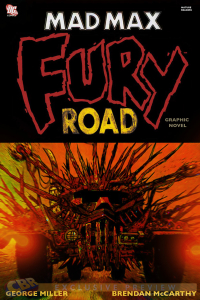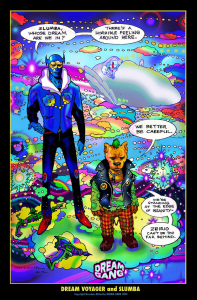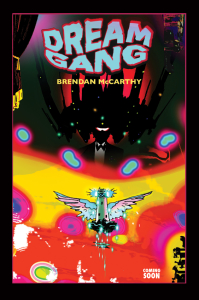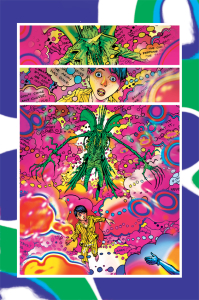By Karl Keily of Comic Book Resources
CBR News: Brendan, how exactly did you come to be involved with “Mad Max: Fury Road” and what’s the journey been like to get it to the screen?
Brendan McCarthy: I used to write to George Miller when I was much younger, as I was totally enthralled by “Mad Max 2: Road Warrior.” It absolutely blew me away when I saw it for the first time in 1981. It mangled my mind — it was “The Matrix” for a previous generation, in that it was highly influential and trend setting. I think I had one of those religious experiences you hear so much about when I walked out of the cinema! I was literally shaking… For most people it was the “Star Wars” trilogy… but for me, it was always “Mad Max.” I couldn’t believe how damn good it was. And still is.
Inspired by “Road Warrior”, I cooked up the comic series “Freakwave” with Peter Milligan, a sort of “Mad Max goes surfing” strip which came out in the early ’80s, many years before the wretched “Waterworld,” I hasten to add.

EXCLUSIVE: The cover for Brendan McCarthy and George Miller’s never-released “Mad Max: Fury Road” OGN.
I met George Miller in Hollywood and we just hit it off. I knew almost everything he had done and I counted him as one of my favorite directors, even though he was strangely below the radar in those days. We yakked about “Mad Max” trilogy for hours, and I even pitched him a totally bonkers “Mad Max 4” storyline! But I didn’t think a new “Mad Max” movie was ever on his agenda at the time.
Anyway, a few months later he asked me over to Sydney to bounce around some story ideas he had. I think he saw the benefits of working with a comic book artist and writer in that you can get a script written and elements visually designed as you go along. And I was steeped in the mythology of the series and had a million new ideas to express. I took the task of co-creating a new “Mad Max” movie as a serious, sacred artistic duty, frankly.
As for the amount of time it’s taken to get “Fury Road” onto the screen, George has outlined the long and winding road in his recent interviews. Back then, it was to be the fourth installment of the Mel Gibson “Max,” but it took so long to get going that Mel eventually dropped out. Thankfully an actor with the required raw talent, Tom Hardy, appeared on the scene. Later, another screenwriter, Nico Lathouris, was brought in to recalibrate the script with George so it would work for the younger Tom Hardy. And as far as I can tell, the long gestation time has only done wonders for the story and design work. I saw quite a bit of a rough cut over a year ago, and it looked sensational even then. The trailer was fantastic and really did steal Comic Con this year. Warners has done a terrific job in getting the “Mad Max” brand back into people’s heads and I’d say this is now one of the most anticipated movies of next year. If the actual movie is half as good as the trailer, then we’re in for a treat.
I am hopeful that the characters of the Five Wives, the teenage girls, will get hordes of young women going to see the movie too, as well as the expected motley mob of petrol heads, punks, freaks and adrenaline junkies! I’m really confident that this film will not disappoint those of us who hold “Road Warrior” in such high esteem. When I was co-writing this with George, we had an informal agreement that if “Fury Road” wasn’t going to be absolutely the f**king bee’s knees, he would flush it and forget about it.
What sorts of designs did you come up with for the characters and vehicles in the film? What inspired your style?
I did the first pass designs on pretty much everything in the movie as we wrote it, working off an electroboard and printing out bits of script and designs as we went along. These were then added to the illustrated script until the story was completed. It went through many radical changes as we went along. Then we started on the storyboards which were edited together to form an animatic/storyreel.
As the years rolled by and different creative teams came and went, the designs evolved into what they look like now. Some of my original vision is intact, and other parts of it have grown into a new visual solution, far better than what was first proposed. The retro-gangster hotrod style of the vehicles was a design philosophy that has remained, as we wanted to move on from the dune buggy look of the trilogy. The Australian comic strip and horror artist Peter Pound in particular, made a brilliant contribution to specific car designs and some new characters. I’d love to see him do some American horror strips.
The first period of writing a movie is always the most wild and creatively loose, before everything gets locked down by dramatic requirements. It’s the brainstorming time and there are lots of drawings of really out there characters and vehicles that were tried out, just for the hell of it, but which didn’t make it. I remember sitting George down and watching segments of the Sex Pistols’ movie “The Filth and The Fury,” for the crazed energy that we’d want for the War Boys sequences.
What was it like co-writing the script with George Miller?
George is a very formidable talent, a hugely intelligent man. He’s got a surreal sense of humor too, which I share, and which percolates all his movies. Just think of Max with a giant clown’s head on in “Beyond Thunderdome,” the bizarre flavour of “Pig in the City,” or Jack Nicholson puking up millions of cherries in “Witches of Eastwick.” He’s a unique Aussie mixture of Terry Gilliam, Spielberg and Kubrick. A major director.
We had a great deal of fun knocking our heads together and building the story and visuals. We both had so many ideas; it was possible to have a great game of creative tennis with him.
He’s mentioned elsewhere that he enjoyed the storyboarding part of the process, where much of the “real writing” gets done. It’s pretty much the way animated movies are put together, which I was very familiar with: Loose first draft, then storyboard to storyreel. The whole thing is one big feedback loop, with the written script continually mutating in tune with the boards. In fact, the final screenplay was more like a hybrid comic book, with images and text running alongside each other. I really hope Warner Bros. will put out a book of this document. I think it’s pretty unique and will be of great interest to other writers and storytellers.
When I went to Namibia to watch the shoot a while back, I saw George in his element, surrounded by monstrous vehicles and insane tribal warriors in a post-apocalyptic scenario. What’s great about it is that he actually created this genre and is its prime exponent. His producing partner, Doug Mitchell who does all his movies, had marshaled what looked like the entire country to achieve the shots needed for the story. They’re a very efficient and successful team.
Is there anything you can tell us about what challenges Mad Max faces in the film?
I don’t want to get into specific sequences and spoil it for viewers, so let me say that thematically, the film deals with human beings as commodities and control over the future of the human race; patriarchy and the emergence of a new matriarchal order; the manipulation of youth by war propaganda and religious cult brainwashing.
One of the most chilling developments was creating a group of kamikaze suicide warriors well before that became a staple of the nightly news after 9/11.
George’s desire that the film be in continuous motion, “one long chase” as he called it, was an exciting hook to hang the drama over and came with its own challenges.
You’re sharing a cover for a never-produced “Mad Max” comic book for this interview. What’s the story behind it? Was “Fury Road” ever going to become a comic instead of a film?
No, “Fury Road” was always created to be a live action feature. The comic book cover was just a mock-up to keep a graphic novel or series in the mix. The idea was that I might adapt the script/boards that I wrote with George into a comic book in its own right. It was never used or seen — until now! I assume at some point DC or whoever, will get some “Mad Max” comics out there. It’s a great opportunity to expand on the “Mad Max” universe.
There is also a big computer game coming out, concurrently developed with the movie over the last few years. George had a big hand in its conception and took the gaming narrative seriously. I had nothing to do with it, as it happened well after my time on the film.
As I haven’t seen the completed movie myself, I can assure you that I am looking forward to it as much as anybody else! It will please me if we have delivered a movie that does justice to the wonderful films that preceded it.
Moving to your creator-owned work, what is your new “Dream Gang” comic series about?
“Dream Gang” is a story that takes place in dreams entirely. It is the story of a young man who lives a dreary gray life, but one night has a enlivening, colorful dream that connects him to a group of naturally gifted ‘dream voyagers’ known as the Dream Gang. They project themselves into other people’s dreams and mess around, going ‘dream surfing.’ A dark conspiracy is stumbled across, which aims to debase humanity while it sleeps… and the Dream Gang are forced to confront its devastating intent.
I don’t want to give too much away about it. I like to keep as many surprises as possible in the actual reading of the comic.
I’m not telling the story as if it’s a film narrative. More like the way “Alice in Wonderland” unfolds in its curios dream logic way. I wanted to create a strip that would allow for an unbridled, imaginative storyline and surreal characters, and to create a comic series that might get close to the creative originality of Steve Ditko’s “Doctor Strange.” I’m both writing and drawing “Dream Gang” and I’m enjoying enormously the creative freedom that brings.
“Dream Gang” has a had a long gestation too, a bit like “Fury Road.”
That’s true. I literally dreamt the basis of this story up about 30 years ago when I was staying in hotel in northern India, in the Kashmiri Himalayas. I was on a “Razor’s Edge” type of spiritual quest, back in the days of the tail end of the 60s’ hippy trail through Asia.
I have pondered this story for decades. I pitched an earlier and different version of this tale under the title of “Z-Men” to Vertigo Comics about 17 years ago, but for some reason, it never happened with them (I think “Mad Max” first came up around that time). Although the core concepts have remained intact, a lot of new characters have been invented that work better in today’s comic book climate, as does the newer title, “Dream Gang.”
One of the cooler design aspects of the book is all the word balloons that make up the backgrounds. Are these the thoughts of everyone who is awake or something else?
The word balloons that clutter up the spaces between the dreamworlds are meant to represent the background chatter of the collective consciousness that our characters move through. Just like your own mind has an endless flow of yakkety-yak babble going on all the time, imagine what 7 billion people sound like!
Also, an important thing for me was to reclaim the thought bubble from the comics’ dustbin, where contemporary writers have shunned it as a narrative device that is somehow dated. I figured, if the writers don’t want it, then the artists can use it, in my case as a visual part of the storytelling grammar. Graphically, thought bubbles can contain images as well as words. I’ve always really loved thought balloons, and wanted them brought back into modern comics. They are an integral part of “Dream Gang.” Indeed they are the overriding emblem of the strip. I have found the humble thought balloon has given me a fantastic symbol for representing different thoughts and imaginative realms.
Welcome back to the thought bubble!
 The Hate-Wraiths are particularly cool villains - made from children’s nightmares. What inspired them and what sorts of other cool creatures will be making their way into “Dream Gang?”
The Hate-Wraiths are particularly cool villains - made from children’s nightmares. What inspired them and what sorts of other cool creatures will be making their way into “Dream Gang?”
A large part of the story is about dream technology, the manufacture of nightmares — and idylls too. Creating monsters of the id from the dark side of the mind is a fun idea. There are, of course, an unlimited amount of creepy concepts that can be married together from the imagination. The story involves a creature invented by The Thought Corps, Zeirio, who has run amok in the psychic realms of this dream-story.
What are some of the wildest dreams or nightmares you’ve personally had?
Well, some of them are featured in the story. I go through periods when I write my dreams down every morning. I’m in one now, because I’m doing “Dream Gang” over the next year and I want to make sure I capture anything inspired. Most dreams are very pedestrian, but now and then something very strange may be recalled which leaves a lingering feeling all day. Dreams that have a strong afterglow are usually worth thinking about.
We spend a third of our lifespan asleep and these bizarre story fragments we tell ourselves at night seem to be largely ignored by society. I reject the use of dreams only as fodder for therapy — it’s somehow taming the last wild space we have inside us, in service of making our mundane day-to-day lives slightly more comfortable. Dreams can be powerful, energetic wild beasts that we try to tame with flimsy psychotherapy ‘meanings’. The controversial writer on dreams, James Hillman, rejects the neutering of these mysterious messages from deep within us for the benefit of our waking egos states. I agree with him. I want to be fully submerged in the mad, surreal, illogical, frightening forces of the deep mind.
Dive deep at night to bring back strange pearls! That’s the unruly spirit that informs “Dream Gang.”
Can you tell us how “Dream Gang” came to be serialized through “Dark Horse Presents?”
It was an easy birth for a change. I pitched it to Dark Horse President Mike Richardson and he said, “Yes” about two days later. It was very quick. I think he was tickled with the concepts and designs and wanted something unusual for the relaunch of “Dark Horse Presents.” I was very pleased with the production of “The Best of Milligan & McCarthy” that Dark Horse put out in 2013. I was happy to work with Mike again after that, and the upcoming editorial superstar, Brendan Wright.
“Dream Gang” will run to 96 pages serialized in twelve, eight-page installments over the next year or so. I’ll do a few covers too. And then we’ll collect it into a graphic novel with pages of extra goodies. It’ll be a nice book, definitely worth having!



